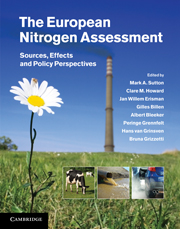Book contents
- Frontmatter
- Contents
- List of contributors
- Foreword
- Summary for policy makers
- Technical summary
- 1 Assessing our nitrogen inheritance
- Part I Nitrogen in Europe: the present position
- Part II Nitrogen processing in the biosphere
- Part III Nitrogen flows and fate at multiple spatial scales
- 10 Nitrogen flows in farming systems across Europe
- 11 Nitrogen flows and fate in rural landscapes
- 12 Nitrogen flows and fate in urban landscapes
- 13 Nitrogen flows from European regional watersheds to coastal marine waters
- 14 Atmospheric transport and deposition of reactive nitrogen in Europe
- 15 Geographical variation in terrestrial nitrogen budgets across Europe
- 16 Integrating nitrogen fluxes at the European scale
- Part IV Managing nitrogen in relation to key societal threats
- Part V European nitrogen policies and future challenges
- Glossary
- Index
- References
15 - Geographical variation in terrestrial nitrogen budgets across Europe
from Part III - Nitrogen flows and fate at multiple spatial scales
Published online by Cambridge University Press: 16 May 2011
- Frontmatter
- Contents
- List of contributors
- Foreword
- Summary for policy makers
- Technical summary
- 1 Assessing our nitrogen inheritance
- Part I Nitrogen in Europe: the present position
- Part II Nitrogen processing in the biosphere
- Part III Nitrogen flows and fate at multiple spatial scales
- 10 Nitrogen flows in farming systems across Europe
- 11 Nitrogen flows and fate in rural landscapes
- 12 Nitrogen flows and fate in urban landscapes
- 13 Nitrogen flows from European regional watersheds to coastal marine waters
- 14 Atmospheric transport and deposition of reactive nitrogen in Europe
- 15 Geographical variation in terrestrial nitrogen budgets across Europe
- 16 Integrating nitrogen fluxes at the European scale
- Part IV Managing nitrogen in relation to key societal threats
- Part V European nitrogen policies and future challenges
- Glossary
- Index
- References
Summary
Executive summary
Nature of the problem
Nitrogen (N) budgets of agricultural systems give important information for assessing the impact of N inputs on the environment, and identify levers for action.
Approaches
N budgets of agro-ecosystems in the 27 EU countries are established for the year 2000, considering N inputs by fertiliser application, manure excretion, atmospheric deposition and crop fixation, and N outputs by plant uptake, gaseous emissions, mineralisation, leaching and runoff.
Country N budgets for agro-ecosystems are based on the models INTEGRATOR, IDEAg, MITERRA and IMAGE. Fine geographic distribution is depicted with the former two models, which have higher spatial resolution. INTEGRATOR is the only available model for calculating non-agricultural terrestrial N budgets systems.
Key findings/state of knowledge
For EU-27, the models estimate a comparable total N input in European agriculture, i.e. 23.3–25.7 Mton N yr−1, but N uptake varies largely from 11.3–15.4 Mton N yr−1, leading to total N surpluses varying from 10.4–13.2 Mton N yr−1. Despite this variation, the overall difference at EU-27 is small for the emissions of NH3 (2.8–3.1 Mton N yr−1) and N2O (0.33–0.43 Mton N yr−1) but estimates vary largely at a regional scale. The estimated sum of N leaching and runoff at EU-27 is roughly equal to the sum of NH3, N2O and NOx emissions to the atmosphere, but estimates vary by a factor two, from 2.7 to 6.3 Mton N yr−1.
[…]
- Type
- Chapter
- Information
- The European Nitrogen AssessmentSources, Effects and Policy Perspectives, pp. 317 - 344Publisher: Cambridge University PressPrint publication year: 2011
References
- 17
- Cited by

